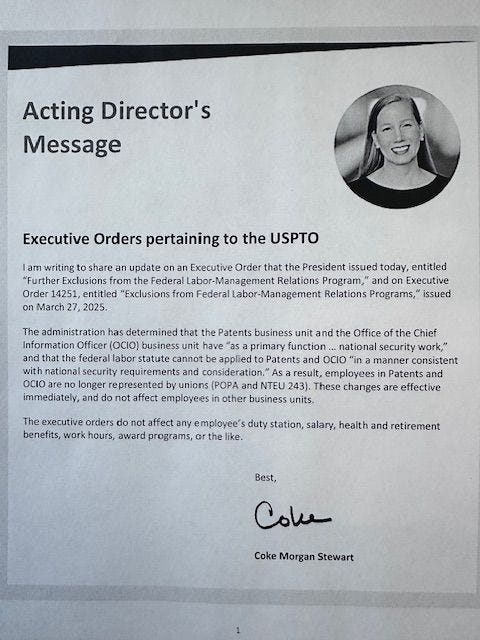USPTO Examiner Union Abolished Under National Security Mandate
A new E.O. says POPA must go
In a new development, the longstanding union representing approximately 9,000 patent examiners and other professionals at the United States Patent and Trademark Office (USPTO) has been dissolved by Executive Order. The Patent Office Professional Association (POPA), which has represented USPTO employees for decades, was decertified effective immediately, citing national security concerns.
The move stems from an Executive Order issued by the White House on August 28, 2025. According to a LinkedIn post of a communication from Coke Morgan Stewart, the Deputy Under Secretary of Commerce for Intellectual Property and Deputy Director of the USPTO, "The administration has determined that the Patents business unit and the Office of the Chief Information Officer (OCIO) business unit have 'as a primary function ... national security work.'"
Stewart's message continues, stating that the federal labor statute cannot be applied to these units "in a manner consistent with national security requirements and consideration. As a result, employees in Patents and OCIO are no longer represented by unions (POPA and NTEU 243)."
This action abruptly ends a relationship that recently appeared to be stronger than ever. In December 2024, the USPTO and POPA signed a new collective bargaining agreement (CBA), which was heralded at the time as a "landmark" agreement that set a "government-leading standard for labor relations."
That CBA governed key aspects of employment for examiners, including telework policies, performance evaluation procedures, and grievance processes.
The Executive Order's Authority
The legal basis for the dissolution is an amendment to Executive Order 12171. The new order, signed August 28, 2025, makes a formal determination that specific government subdivisions have national security work as a primary function. Section 2 of the order revises the list of excluded agencies to include the "Office of the Commissioner for Patents and subordinate units, Patent and Trademark Office."
The order states, "It is also hereby determined that Chapter 71 of title 5, United States Code, cannot be applied to these agencies and agency subdivisions in a manner consistent with national security requirements and considerations." This provides the legal mechanism for removing these employees from the federal labor-management relations program, effectively ending union representation.
Analysis of the Shift
This policy change introduces significant new variables into the functioning of the USPTO, an agency central to the nation's innovation economy.
From the administration's viewpoint, the primary benefit is enhanced control and flexibility over a workforce deemed critical to national security. By removing the collective bargaining framework, USPTO management can implement policy changes more rapidly, without the negotiation process required by a union agreement. This could, in theory, allow the agency to respond more nimbly to national security-related patent matters, such as those governed by secrecy orders under 35 U.S.C. § 181.
The immediate challenge is the operational vacuum created by the sudden invalidation of the CBA. The agreement provided a stable, predictable framework for labor-management relations. Without it, there is no established process for negotiating changes to working conditions or for resolving disputes and grievances. This uncertainty could lead to significant internal disruption as both management and employees adjust to a new, undefined relationship.
Risks
The risks associated with this decision are substantial and could have long-term effects on the U.S. patent system.
Examiner Morale and Retention: The patent examination corps is a highly specialized workforce that requires years of training and experience. The removal of their representative body, which advocated for work-life balance initiatives like telework, could severely damage morale. A decline in morale often precedes a decline in productivity and, more critically, could lead to a wave of resignations or early retirements. Losing experienced examiners would directly impact patent quality and could increase the patent application backlog.
Operational Instability: With the CBA gone, fundamental aspects of an examiner's job, from performance metrics to telework eligibility, are subject to unilateral change by management. This instability makes it difficult for the agency to attract and retain top talent, which is essential for examining increasingly complex technologies.
Legal Uncertainty: The "national security" justification as applied to the entire patent examination corps is likely to face legal challenges. Affected unions will probably contest the Executive Order in federal court, arguing its scope is overly broad. The resulting litigation will create a prolonged period of uncertainty for the agency and its employees.
Conclusion: A New Era of Uncertainty for the USPTO
The dissolution of POPA marks a fundamental change in the operational structure of the USPTO. While the stated goal is to protect national security, the move introduces considerable risk and uncertainty for the patent system.
IP owners, patent practitioners, and inventors rely on a stable, consistent, and high-quality examination process. The USPTO backlog is already too high.
The morale and stability of the patent examination corps are foundational to that process. The IP community should watch this situation closely, as the downstream effects on patent pendency, examination quality, and the overall health of the U.S. innovation ecosystem are yet to be seen.
Disclaimer: This is provided for informational purposes only and does not constitute legal or financial advice. To the extent there are any opinions in this article, they are the author’s alone and do not represent the beliefs of his firm or clients. The strategies expressed are purely speculation based on publicly available information. The information expressed is subject to change at any time and should be checked for completeness, accuracy and current applicability. For advice, consult a suitably licensed attorney and/or patent professional.




